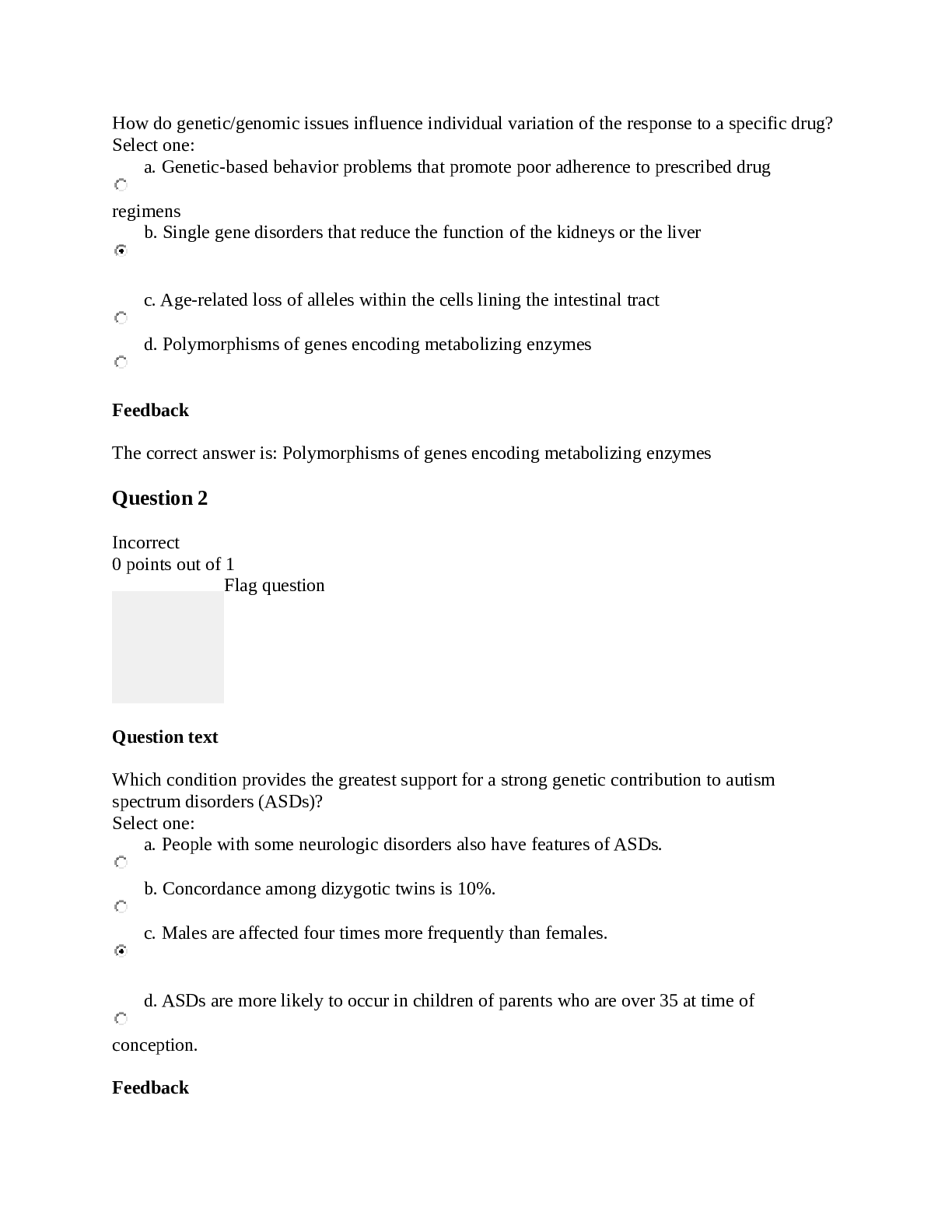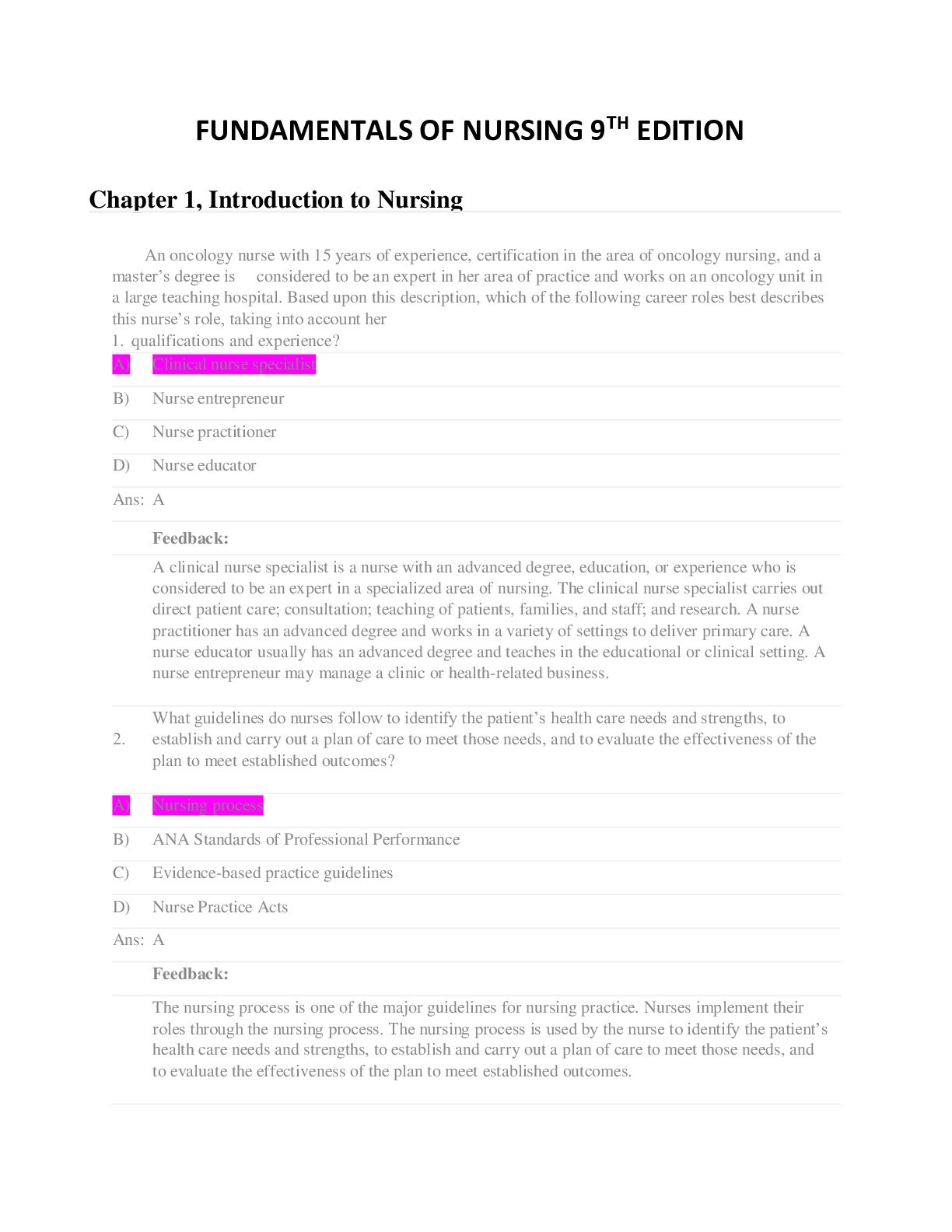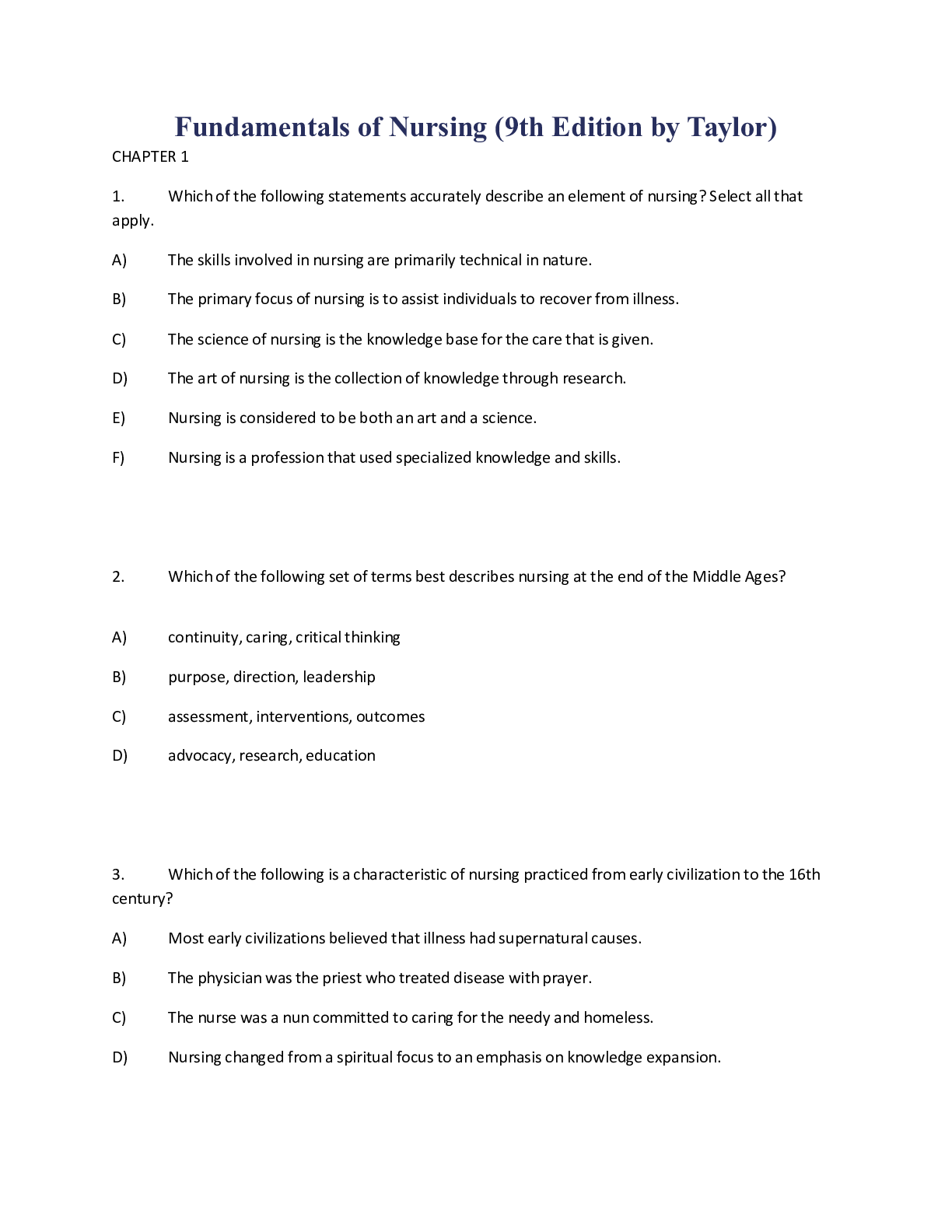*NURSING > EXAM > [Solutions Manual with Test Bank] Mergers, Acquisitions, and Other Restructuring Activities 9th Edit (All)
[Solutions Manual with Test Bank] Mergers, Acquisitions, and Other Restructuring Activities 9th Edition by Donald Depamphilis
Document Content and Description Below
Chapter 2 The Regulatory Environment Answers to End of Chapter Discussion Questions 2.1 What factors do U.S. antitrust regulators consider before challenging a merger or acquisition? Answer: Regulator... s attempt to measure the likelihood of increased market power, i.e., the ability to raise prices resulting from a business combination. Initially, regulators examine the size of the market and the increase in industry concentration that might ensue. Other factors that are considered include the potential for coordinated interaction among current competitors, the extent to which products are differentiated in the minds of consumers, and the similarity of substitute products. Frequently, M&As can be approved if it can be demonstrated that the combination of certain businesses will result in enhanced efficiency and eventually lower prices. Finally, regulators consider the likelihood that a firm would fail if it were not merged with a more viable business. 2.2 What are the obligations of the acquirer and target firms according to Section 14(d) of the Williams Act? Answer: The acquirer must disclose its intentions and business plans as well as any agreements between the acquirer and the target firm in a Schedule 14D-1. The disclosure must also include the types of securities involved, the identities of the person, partnership, syndicate, or corporation that is filing, and any source of funds used to finance the tender offer. The target firm cannot advise its shareholders on how to respond to the tender offer until it has filed a Schedule 14D-9 with the SEC inside 10 days after the tender offer’s commencement date. 2.3 Discuss the pros and cons of federal antitrust laws. Answer: Such laws are intended to prevent individual corporations from assuming too much market power such they can limit their output and raise prices without concern for any significant competitive reaction. Antitrust laws such as the Hart-Scott-Rodino Act require that the firms involved in the pending transaction notify the regulatory authorities before completing the transaction. The regulators thus have time to assess the potential anticompetitive effects of the transaction before hand to avoid the disruption involved in dismembering the combination once it has been completed. Using consent decrees, regulators are able to reduce potential concentration by requiring the parties to the transaction to divest substantially overlapping portions of their businesses (so-called structural decrees) or to pursue policies minimizing anticompetitive practices (so-called behavioral decrees). The ability of regulators to assess accurately potential anticompetitive effects is often questionable. Defining concentration is heavily dependent on their ability to define the market, ease of entry for new competitors, current competitors (including foreign), the availability of substitute products, and the extent to which products are differentiated. Inappropriate challenges to M&As may thwart potential improvements in efficiency and innovation. Antitrust policy sometimes ignores market dynamics such as the accelerating change in technology, which may result in the introduction of new substitute products, thereby undermining the dominant firm’s competitive position. 2.4 When is a person or firm required to submit a Schedule 13D to the SEC? What is the purpose of such a filing? Answer: Any person or firm acquiring 5% or more of the stock of a public corporation must file a Schedule 13D with the SEC within 10 days of reaching that percentage ownership threshold. The disclosure is necessary even if the accumulation is not followed by a tender offer. The filing is intended to give target shareholders access to sufficient information and an adequate amount of time to evaluate properly a tender offer. 2.5 Give examples of the types of actions that may be required by the parties to a proposed merger subject to a FTC consent decree? Answer: A typical consent decree requires the merging parties to divest overlapping businesses (structural decrees) or take actions (behavioral decrees) that minimize activities that are perceived by the regulators as anticompetitive. 2.6 Having received approval from the Justice Department and the Federal Trade Commission, Ameritech and SBC Communications received permission from the Federal Communications Commission to form the nation’s largest local telephone company. The FCC gave its approval of the $74 billion transaction, subject to conditions requiring that the companies open their markets to rivals and enter new markets to compete with established local phone companies. SBC had considerable difficulty in complying with its agreement with the FCC. Between December 2000 and July 2001, SBC paid the U.S. government $38.5 million for failing to provide adequately rivals with access to its network. The government noted that SBC failed repeatedly to make available its network in a timely manner, to meet installation deadlines, and to notify competitors when their orders were filled. Comment on the fairness and effectiveness of using the imposition of heavy fines to promote government-imposed outcomes, rather than free market outcomes.. Answer: The use of fines to achieve social objectives assumes that the government can provide a better solution than the free market. In general, the imposed solution will be less efficient that what the free market would have determined. It requires the government to determine what constitutes a fair solution. Such definitions are often arbitrary, politically motivated, and result in less innovation and less product variety offered to customers and, in some cases, higher prices. The usual justification for the use of fines in a regulated industry is that industries such as utilities are “natural monopolies” not subject to competitive market conditions. While this may have been a compelling argument in the past, it is less relevant today due to the emergence of a variety of competing technologies such as voice over internet and wireless telephony. 2.7 In an effort to gain approval of their proposed merger from the FTC, top executives from Exxon Corporation and Mobil Corporation argued that they needed to merge because of the increasingly competitive world oil market. Falling oil prices during much of the late 1990s put a squeeze on oil industry profits. Moreover, giant state-owned oil companies are posing a competitive threat because of their access to huge amounts of capital. To offset these factors, Exxon and Mobil argued that they had to combine to achieve substantial cost savings. Why were the Exxon and Mobil executives emphasizing efficiencies as a justification for this merger? Answer: Current antitrust guidelines recognize that the efficiencies associated with a business combination may offset the potential anti-competitive effects of increased concentration. The guidelines call for an examination of the net effects of the proposed combination. Proving that the presumed efficiencies justify the merger is difficult, since most synergies will not be realized for a number of years. It is therefore difficult to measure their true impact and often even more difficult to unravel the anticompetitive impacts that might ensue from the merger. 2.8 Assume that you are an antitrust regulator. How important is properly defining the market segment in which the acquirer and target companies compete in determining the potential increase in market power if the two firms are permitted to combine? Explain your answer. Answer: Whether a company is able to engage in anticompetitive practices is heavily dependent on how the market is defined. The presumption is that the degree of pricing power is directly related to the degree of market concentration. If the market is defined narrowly, the Herfindahl index will show a much higher level of concentration than if the market is more broadly defined to include regional, national, or foreign sources of supply.. 2.9 Comment on whether antitrust policy can be used as an effective means of encouraging innovation. Explain your answer. Answer: Regulation almost always is reactive rather than proactive. Efforts to promote innovation through regulation may be particularly inappropriate in that the conditions that give rise to innovation are not well understood. For example, efforts to establish product standards may promote innovation by enabling software developers to focus on developing new products for the Windows standard. Without a standard, the risk of developing new applications is higher due to the potential for developing products for operating systems that achieve a relatively low market share in the future. However, the existence of standards may also make it possible for companies such as Microsoft to stifle innovation by embedding innovative ideas developed by others in their operating system as they have done in the past. 2.10 The Sarbanes-Oxley Act has been very controversial. Discuss the arguments for and against the Act. Which side do you find more convincing and why? Answer: Detractors argue the Act is overkill in that it imposes costly and unnecessary burdens on firms. They argue that many firms have de-listed from the major exchanges in recent years because of these added reporting costs. There is evidence that the Act has been disproportionately burdensome on small firms. However, changes in the law may alleviate this problem. Proponents argue that, while hard to quantify, the Act has increased public confidence in the equity markets and at least reduced the perception of fraud. While some firms have de-listed, this does not mean that they will be able to avoid the reporting requirements of the Act if they issue high yield debt to finance their LBO. To the extent the Act promotes better governance, it is likely to be worth the additional expense. However, the inability of the Act to mitigate the collapse in U.S. financial markets in 2008 raises serious questions about its effectiveness in promoting greater financial transparency. Solutions to End of Chapter Case Study Questions Regulators Approve Merger of AT&T and DirecTV But Not Comcast and Time Warner Cable NEW Discussion Questions 1. The net neutrality principle states that all legal content providers should have equal access to the internet and that no provider can gain faster access to the internet by paying a premium price. Internet service providers (ISPs) which are now regulated by the FCC as public utilities argue that net neutrality reduces the incentive for firms to innovate because they cannot charge for premium services that might require faster network speeds than other services. In your opinion is innovation helped or hurt by net neutrality rules? How are all content providers forced potentially to pay more to ISPs for online access as a result of net neutrality rules? Explain your answers. Answer: ISP innovation could be discouraged under net neutrality rules. Treating all content providers equally means that the ISPs cannot recover the cost associated with a content provider whose data delivery requires a larger portion of available “pipe” space and speed such as online videos. Netflix streaming of movies requires disproportionately more line space and speed than other content providers. Yet, they pay the same rate even though they transmit far more data than other providers of content. ISPs increase their infrastructure such as servers to accommodate these big users and incur significant cost in doing so. If ISPs cannot recover the full cost of developing new services plus a profit to compensate for risk, there is little incentive for innovation. However, innovation at non-ISPs content providers could be encouraged as they are given the same access under similar conditions to other content providers. To recover the incremental costs of data providers such as Netflix, all users must pay a higher rate than would otherwise be the case. That is, rates paid by smaller content providers subsidize the rates paid by “pipe hogs” such as Netflix. 2. Should regulators in your opinion have extracted more concessions from AT&T before granting approval to merge with DirecTV? Explain your answer. Answer: There is a temptation to use whatever leverage one has to extract as much from the other parties to the negotiations as possible. However, if regulators are to serve the public interest they must balance the benefits to the consumer of a merger against the need to ensure that the new company formed is financially viable. In this instance, the FCC and the Justice Departments are looking to create three viable competitors to ensure effective competition which in theory should maintain rates charged consumers at levels that are affordable and offer a return to the company sufficient to recover costs plus a profit to compensate shareholders for their investment risk. 3. As a regulator, would you have approved the takeover of DirecTV by AT&T? Explain your answer. Answer: DirecTV’s core satellite pay TV business was mature and likely to decline as consumers migrate to watching videos online on a variety of mobile devices. Since the firm did not have broadband capability it would be unable to compete in the online video market as an independent company. Consequently, DirecTV if it remained independent would have become an increasingly weaker competitor over time. The merger arguably could have saved DirecTV from eventual financial failure. 4. Free markets discriminate among consumers based on price: those that can afford a product or service can get it and those that can’t don’t. Net neutrality offers everyone equal access to the internet. Of these two options, which do you believe is most fair? Explain your answer. Answer: It is tempting to say that giving everyone equal access is more desirable because it is in some sense the fairer option. What net neutrality really means is that everyone will be treated equally but to a slower service and less data usage than some others might be willing to pay for. Free markets rely on price which gives people choice to decide what they want to buy and what they don’t. Price also provides the important function of telling businesses what people value the most. This helps businesses make investment decisions. That is, if more consumers are willing to pay more for greater data usage and faster line speed then ISPs would be inclined to upgrade their capabilities to supply these demands. In contrast, if all users are treated the same then those wanting more speed and data capacity would be disappointed and those willing to settle for less would be unhappy as they would be paying more than they would if services were being priced according to what consumers actually wanted. 5. Whose interests do you believe antitrust regulators represent? What trade-offs do antitrust regulators face in making decisions that impact the groups whose interests they represent? Be specific. Answer: Antitrust legislation was passed with the objective of ensuring that firms could not engage in what were viewed as anticompetitive practices. These included gaining excessive market share such that they could effectively set prices or collude with competitors to restrain competition to achieve the same objective. Ostensibly, the regulatory authorities set up to enforce legislation are intended to represent the interests of consumers. In practice, regulators often consider the impact on firm viability, employment, suppliers, creditors, and communities. In effect, to carry out their mandate to protect consumers, the regulators often look at the firms they regulate as stakeholders. In making decisions, regulators consider the trade-off between lower consumer prices and possibly less innovation and safety due to lower reinvestment in the business. That is, lower prices often mean lower profitability and financial returns providing less incentive for the businesses to reinvest and a reduced ability to attract capital. Less reinvestment also limits expansion and employment opportunities. Moribund profitability [Show More]
Last updated: 1 year ago
Preview 1 out of 57 pages
Instant download

Buy this document to get the full access instantly
Instant Download Access after purchase
Add to cartInstant download
Reviews( 0 )
Document information
Connected school, study & course
About the document
Uploaded On
Jul 27, 2021
Number of pages
57
Written in
Additional information
This document has been written for:
Uploaded
Jul 27, 2021
Downloads
0
Views
22


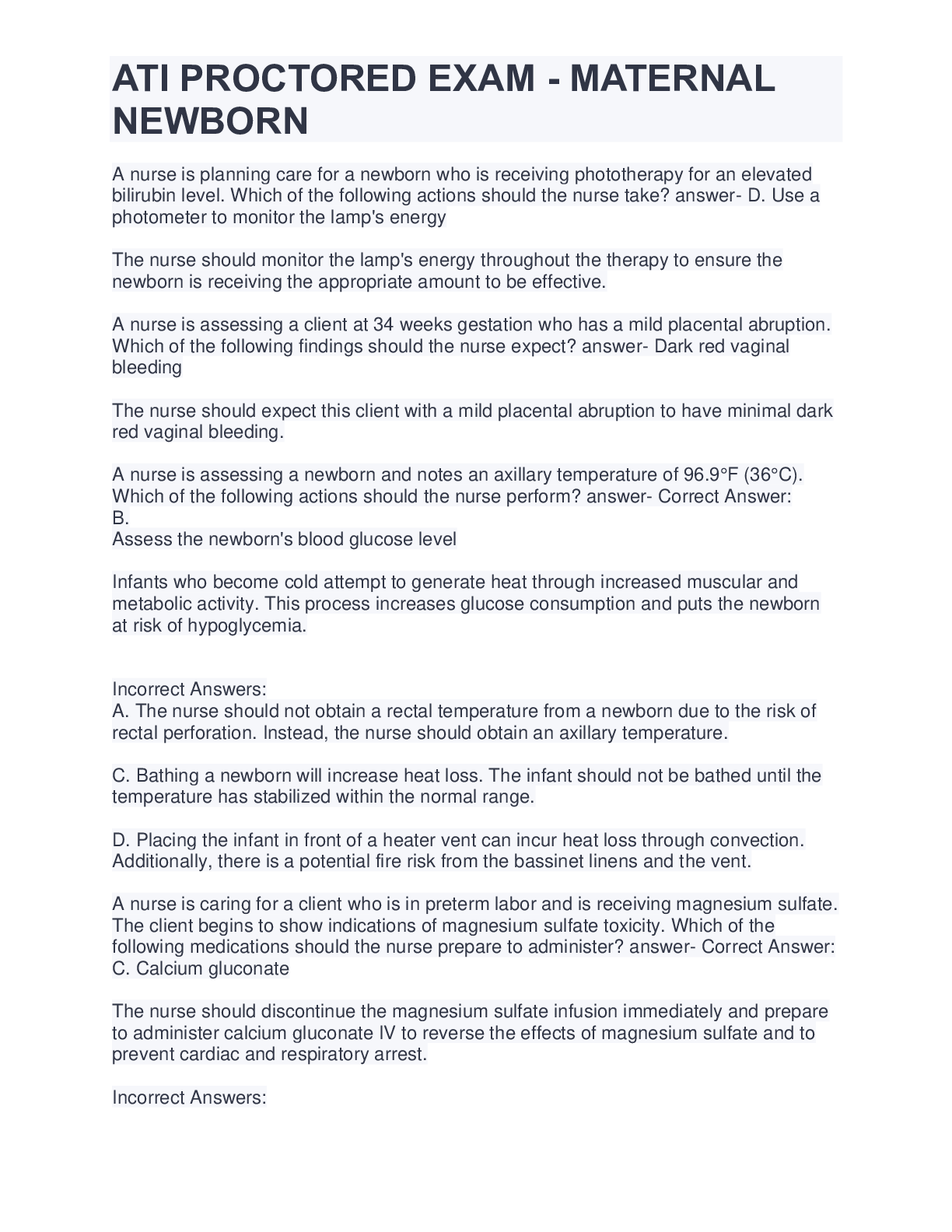


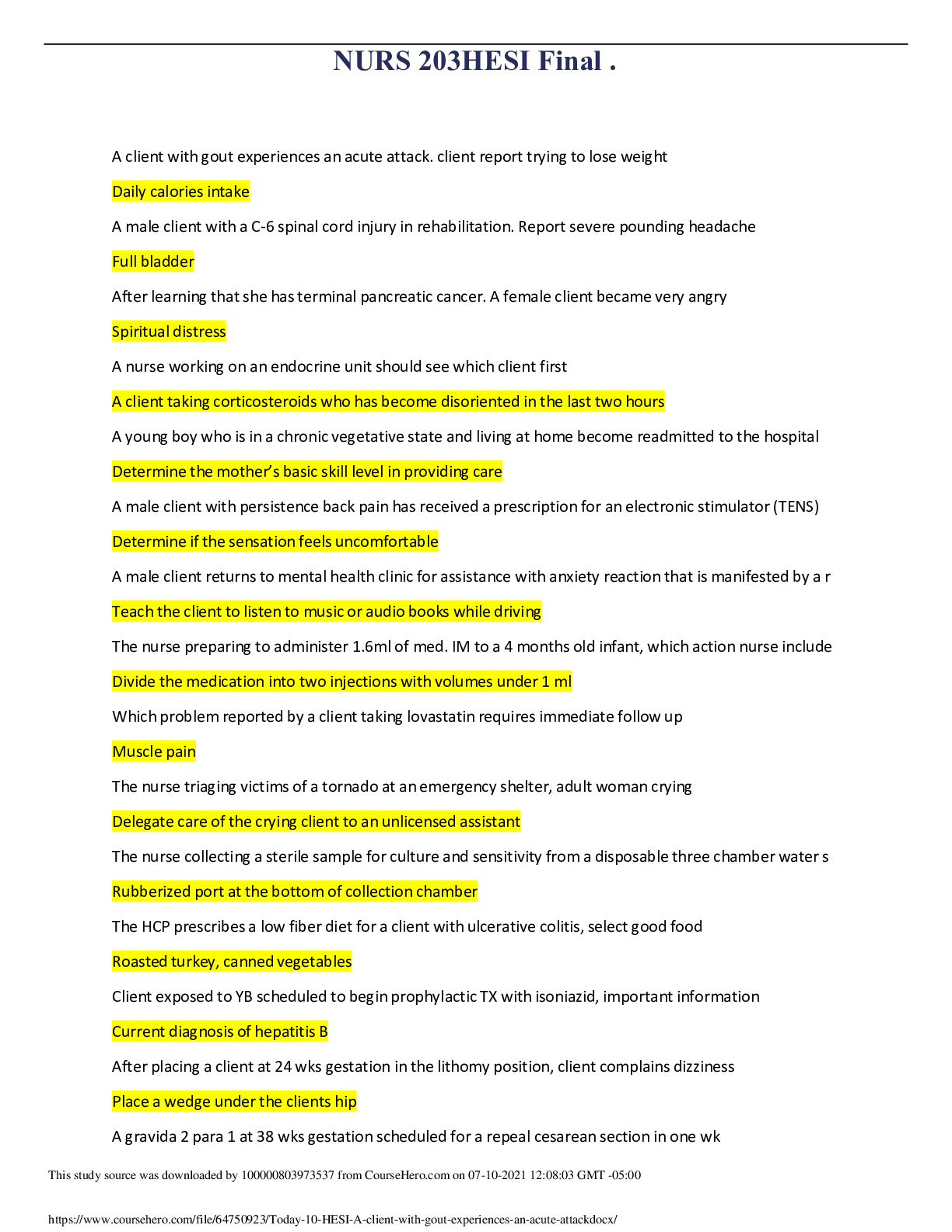
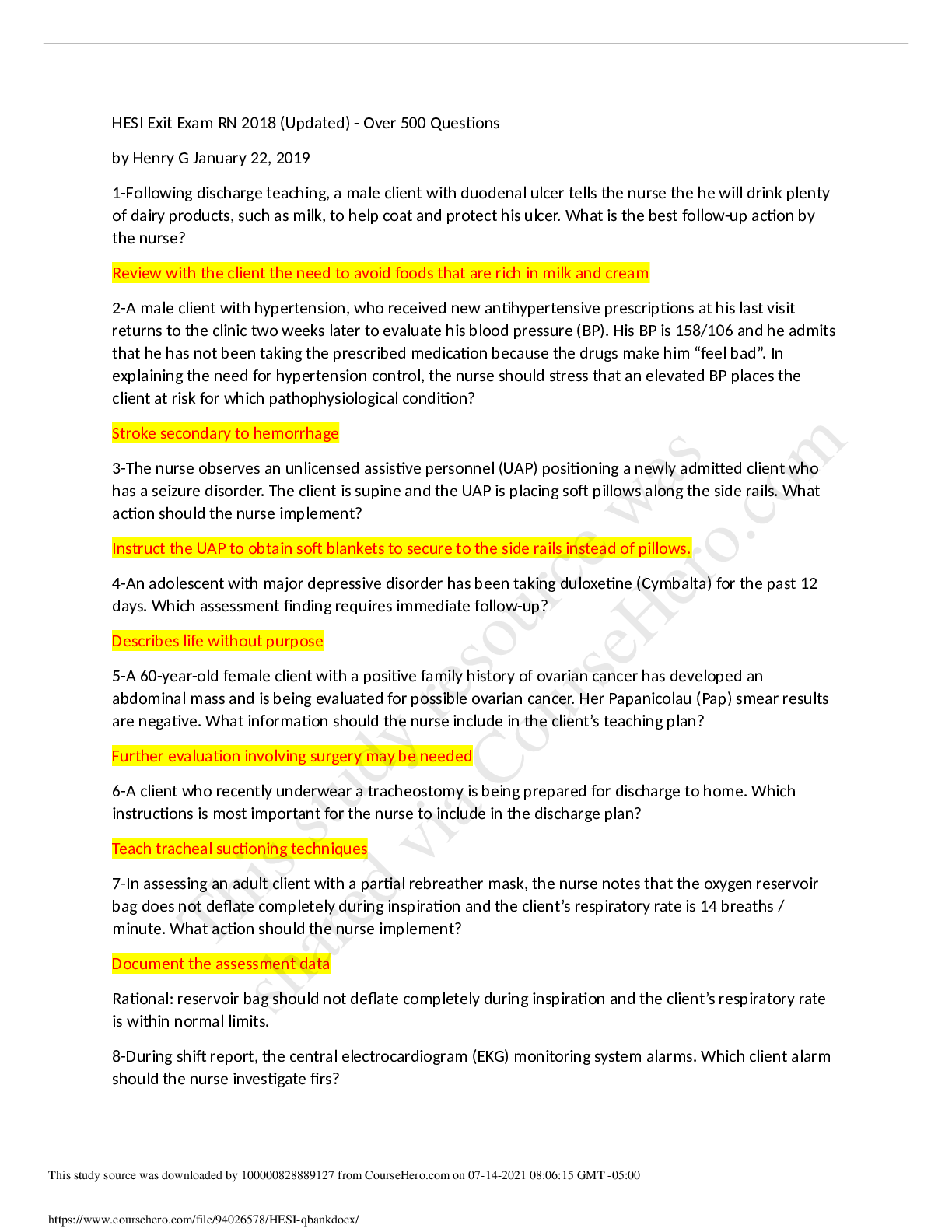


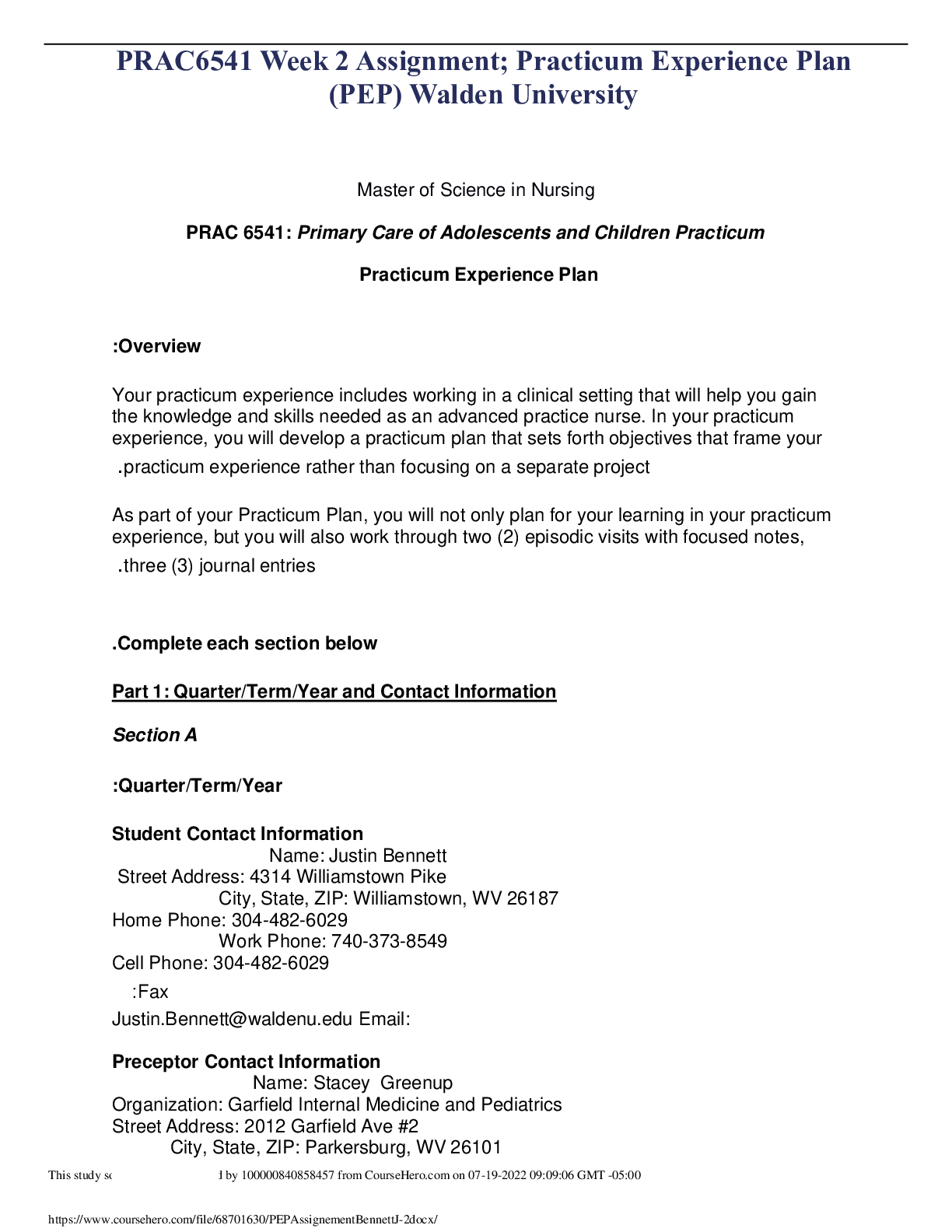
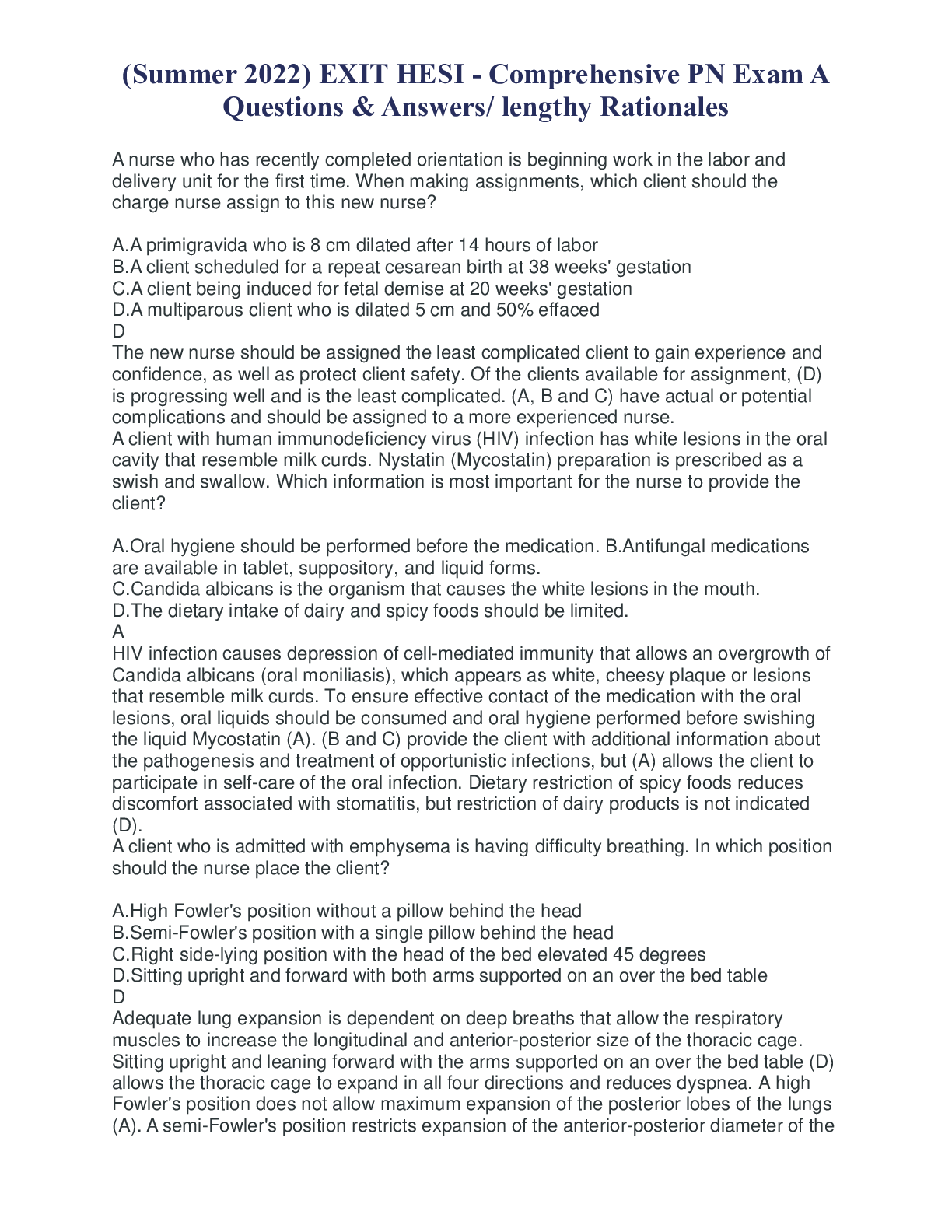




.png)
